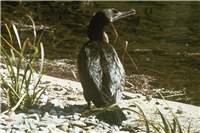Family
Phalacrocoracidae
Genus
Phalacrocorax
Species
sulcirostris
Threats/Control Methods - Regional
In times of prolonged drought, species numbers decline, as they will only breed when the water levels around a waterbody exceed a certain level. They are threatened by the diversion of water away from naturally flowing rivers and wetlands into irrigation and human use.
Threats/Control Methods - Local
Water bodies in urban areas are less resilient against periods of droughts or extreme weather events, causing a build-up of toxins and dangerous algae levels, which may impact the health of this species. In particular, the Jerrabomberra Creek Catchment, home to many of the local Little Black Cormorants, is currently degraded from grazing, polluted stormwater from the Hume industrial estate, road surface runoff and rural residential developments.
Local/Urban Actions
It is important that our waterways remain free from pollution, to encourage healthy aquatic species. Joining in with a local Waterwatch activity can help improve water quality. At home, it is important avoid chemicals, pet faeces or garden waste going down the stormwater drain. Keep gutters clean and call the Canberra Connect helpline on (02) 6207 9777 for specific chemical waste disposal information. Joining a Landcare revegetation activity around a local waterbodies will also improve the habitat areas for this species.
Common Names
Little Black Cormorant, Little Black Shag
Distinguishing Features
This medium sized water bird is 55-65cm and entirely black in colour. It has a dark grey, narrow bill with a hooked tip and dark webbed feet. It has bright jade-green coloured eyes. At the beginning of the breeding season, a small patch of white feathers appears at the side of the head. Young birds have a dark brown, spotty appearance with a brown eye.
Survey Techniques
Call and visual identification.
Species Call
This bird is usually silent, with occasional ticking and croaking.
Similar Species
The Great Cormorant (Phalocrocorax carbo) is much larger and has yellow facial markings, while the Little Pied Cormorant (Phalocrocorax melanoleucos) is similarly sized with obvious white underparts and a yellow bill.
Distribution
This species is common to areas across Australia with good inland water bodies. It is also found in part of Indonesia, New Guinea and New Zealand.
Country of Origin
Australia
Conservation (Pet/Pest) Status - Regional
This species is slightly less common around this region than the Little Pied Cormorant (Phalocrocorax melanoleucos) and is very rare, sometimes seen at Lake Burley Griffin or at the Jerrabomberra Wetlands.
Conservation (Pet/Pest) Status - National
Secure, not listed under the EPBC Act 1999.
LSCCES Population
A few sightings were made on the lake's edge in Civic West and on the ANU campus.
Associated vegetation community
This species will inhabit a variety of inland waters such as lakes, river pools, farm dams, deep-water swamps, lagoons and estuaries.
Limiting Resources
The Little Black Cormorant prefers to inhabit large, deep waterbodies surrounded by thick vegetation and holding a large number of fish species. Areas choosen for breeding must have trees standing in the water. Rainfall is important, as they will only breed when water levels around wetlands are extremely high.
Breeding
The Little Black Cormorant breeds in response to good rain conditions. They prefer to build their nests in trees that stand in the water, as far away from land as possible. They generally nest with other similar waterbird species, such as other cormorants, darters, herons, ibis and spoonbills. The nest can be at any height where a good branch is available, built into a platform of sticks and reeds, with soft bark and feather lining. Their 3-5 eggs are white with a faint blue-green tint, needing 3-4 weeks of incubation by both parents.
Behaviour
This species travels with strong, rapid wingbeats and smooth glides, keeping together in a neat 'V' formation. They spend time in groups, feeding cooperatively on fish with leap-frogging and diving actions. They are most often seen sunning themselves, perched on dead tree branches, poles or boats with wings slightly spread.
Functional Group
Food Species
The thin bill of this waterbird allows it to take a wide range of aquatic animals as prey, grouping together to herd large schools of fish.
Predators
Feral Pigs (Sus Scrofa) are known to push through wetland vegetation, destroying nests and eggs. European Red Foxes (Vulpes vulpes), Dogs (Canis familiaris) and Cats (Felis catus) will also attack young birds.
Interesting Fact
Hundreds of birds group together to herd fish, birds at the back leap-frogging over those in the front to dive underwater.
References - (reader suitability of references, P=Primary teachers, S=Secondary students, T=Tertiary students and researchers)
Books:Morcombe, M. 2000. Field Guide to Australian Birds. Steve Parish Publishing. Archerfield. Australia P, S, T
Schodde, R. and Tideman, S. (eds) 1990. Reader's Digest Complete Book of Australian Birds (2nd Edition). Reader's Digest Services Pty Ltd. Sydney. P, S, T
Taylor, M. and Day, N. 1993. Field Guide to the Birds of the ACT. National Park Association of the ACT Inc. Canberra. P, S, T
Internet: Canberra Ornithological Group (COG). 2004. Birds of Canberra Gardens. COG and the ACT Department of Urban Services. [online]. Available at:http://garden.canberrabirds.org.au/ P, S, T
Online Publications:ACT Government. 2006. Information Sheet: Stormwater Pollution from Residential Areas. Environment ACT. [online]. Available at: http://www.environment.act.gov.au/__data/assets/pdf_file/13168/Stormwater_Pollution_from_Residential_Areas.pdf P, S, T
Nix, H. and Cunningham, R. 2006. Birds of the Lower Sullivans Creek Catchment, Canberra ACT. Prepared for the Life in the Suburbs project using data from the Lower Sullivans Creek Catchment Ecological Survey (LSCCES). Australian National University. Canberra. [online]. Available at: http://www.lifeinthesuburbs.com.au/category.php?id=65 S, T
Queanbeyan City Council. 2004. Study on the Current State of Jerrabomberra Creek . Maunsell Australia Pty Ltd. Canberra. [online]. Available at: http://www.qcc.nsw.gov.au/Documents/YRJTKVCEDKP.pdf S, T
Olsen, P. and Weston, M. 2004. The State of Australian Birds 2004: Water Wetlands and Birds. Birds Australia. [online] Available at: http://www.environment.gov.au/biodiversity/publications/birds-04/regional.html S, T

 Top
Top Top
Top